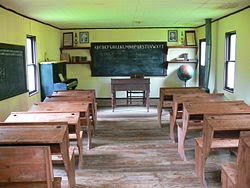Yet, what we think of
today as public education, K-12, hasn’t been around all that long.
In 1644 the Dedham (MA) town meeting established the first tax-supported public school. Of course, it was for boys only. For long decades, girls might learn to read (so they could read the Bible, for instance), but it wasn’t thought important for them to be able to write or do their ciphers.
 |
| One-room school, rural Oklahoma, early 1900s |
In New England, in the 18th century, “common schools” were established, mostly in the form of one-room schoolhouses for students, who often paid a fee to the teacher.
For most kids, the development of reading, writing and math skills was mostly a family concern until about the middle of the 19th century. By that time, public education and public high schools were becoming common, and attendance was in the process of being made mandatory.
What was taught in this evolution of schools was largely a local concern, often tied to the training and interests of the teacher.
It wasn’t until the early 1900s that a nationwide standardized curriculum was established, mandating roughly the same array of classes that students are taking today: mathematics, English, science and history.
I guess you could say we’ve come a long way, baby….but I guess that Americans have never been less proud of our public education than we are today.
I wonder what an 18th century schoolmarm would have thought about the Common Core standards?
My guess is that she probably wasn’t giving passing grades to students who just weren’t getting it….that seems like the bottom line to me.
No comments:
Post a Comment